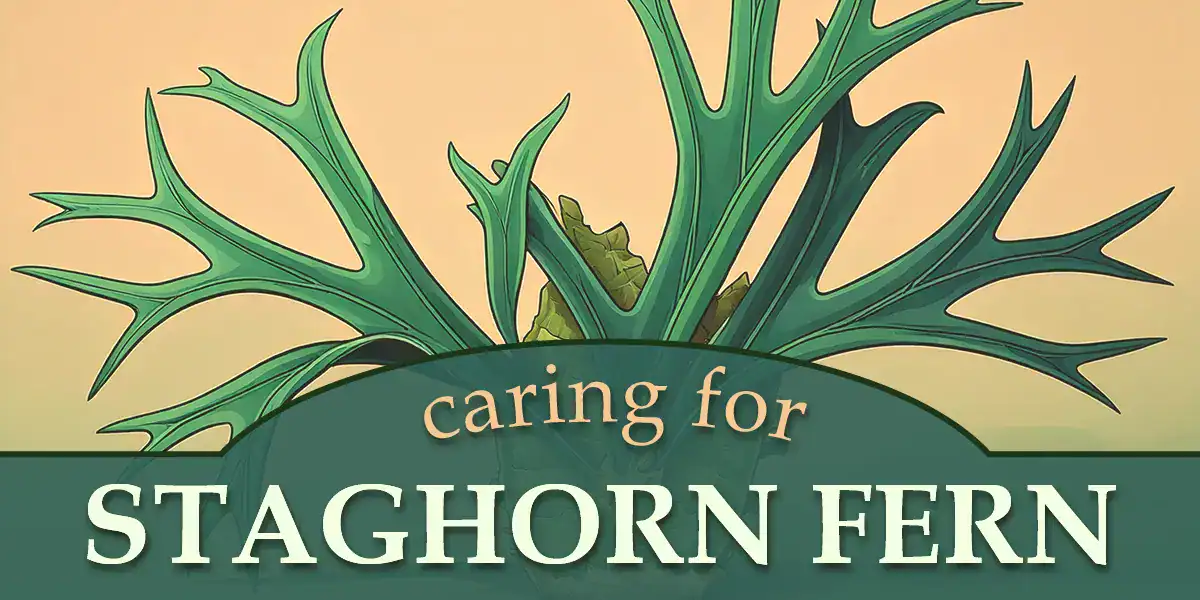Staghorn ferns don’t grow in soil. In the wild, they cling to trees, rocks, or cliff faces, absorbing moisture and nutrients from rain and decaying leaves. Over time, multiple ferns fuse into a giant colony that can blanket entire tree trunks. They don’t harm their host — they just hitch a ride.
Staghorn ferns bear two types of leaves.
- Shield fronds are round and flat, protecting the roots and trapping organic matter.
- Fertile fronds are long and forked like antlers and bear spores for reproduction.
With the right care, a plant can live 50–100 years. Some massive specimens in botanical gardens are older than the people who tend them, reaching 4–6 feet across and weighing over 200 pounds.
With luck, maybe you can grow such a magnificent fern in your living room!
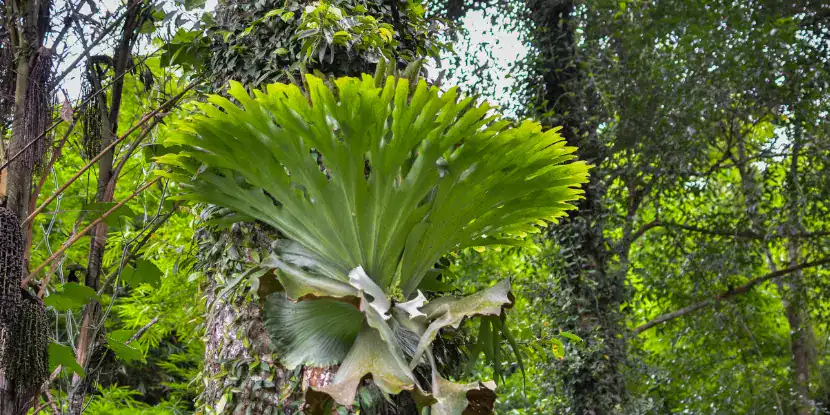
An old and well-established staghorn fern in the forest.
Care Requirements
You can mount a staghorn fern on a wooden board, a wire basket, or even a hanging plaque. This epiphytic plant needs only light misting and occasional feeding, mimicking the conditions of its natural forest habitat.
Light
- Place your fern near a window with bright, indirect light. East-facing windows work well.
- Direct sunlight can scorch the fronds, causing brown spots.
- Low light may slow growth. Supplement with grow lights in dimmer spaces.
- Rotate your fern occasionally to prevent uneven development.

Platycerium Foong Siqi is a rare staghorn fern with pale curls at the end of its fronds.
Temperature
Staghorn ferns prefer a stable, warm environment.
- Keep the temperature between 60°F and 80°F (15°C to 27°C).
- Avoid exposing your staghorn fern to temperatures below 50°F, which can stress or kill the plant.
- Staghorns love high humidity (50%-75%). A bathroom with a window or a humidifier nearby can offer the perfect setup.
- If humidity is low, mist your fern with water once or twice a week to keep the fronds hydrated.
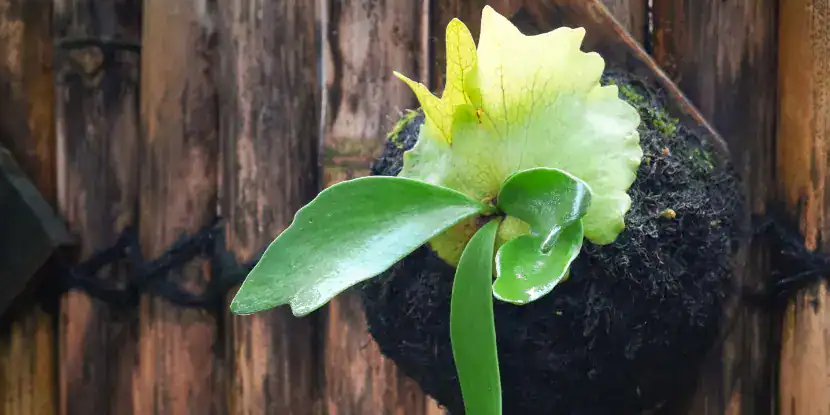
A young staghorn fern attached to a wall.
Watering Needs
- Frequency: Water the fern when the mounting material feels dry. In most indoor environments, this is every 7–10 days.
- How to Water: Take the fern off its mount or pot and soak it in lukewarm water for 15–20 minutes. Shake off excess water before re-hanging it.
- Do Not Overwater: Yellowing fronds can indicate too much water and potential root rot. Always allow the mounting material to dry out slightly between waterings.
During winter, reduce watering frequency as the plant’s growth slows.
Propagation Methods
Propagating a staghorn fern is usually done by dividing pups from a mature plant.
- Look for small offsets growing near the base of the fern.
- Gently detach the pup along with some of the mother plant’s basal fronds. Use a clean, sharp knife if necessary.
- Attach the pup to a piece of wood, cork, or a hanging basket. Secure it with twine, fishing line, or old pantyhose while it establishes roots.
- Care for the pup as you would a mature fern, ensuring proper moisture and light.
If your plant isn’t producing pups, no sweat! Healthy ferns will propagate on their own timeline.
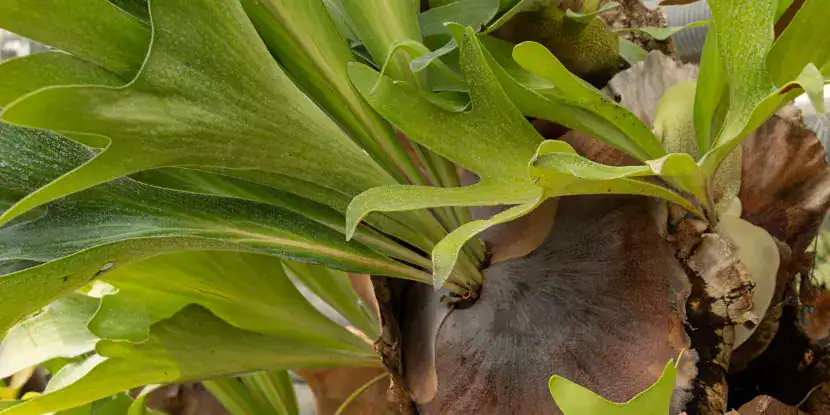
Staghorn fern foliage and fronds.
General Maintenance Tips
- Feeding: Use a balanced liquid fertilizer diluted to half strength. Apply once a month during the active growing season (spring and summer).
- Trimming: Remove dead or brown fronds to keep the plant tidy, but never cut the basal fronds (the shield-like ones at the base), which protect the root system.
- Repotting: When the plant outgrows its mount or basket, reattach it to a larger piece of wood or pot.
- Pest Control: Inspect occasionally for pests like spider mites or mealybugs. Wiping the fronds with a damp cloth can remove pests and their eggs.
Consider mounting your fern on driftwood for an impressive and arty display or creating a living wall with several plants.
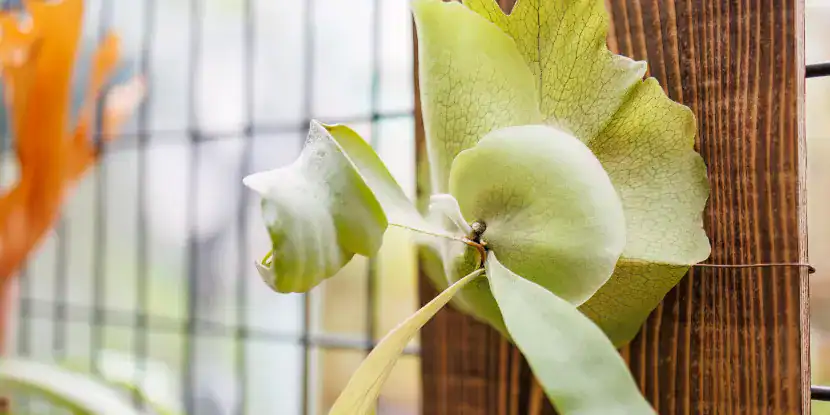
An indoor staghorn fern mounted on a board.
FAQs: Staghorn Fern Care
Q: Can staghorn ferns live in low light?
Yes, they can tolerate low-light conditions, but won’t grow as robustly. Bright, indirect light is ideal for their health.
Q: How do I know if my staghorn fern needs water?
Check the mounting material — if it feels dry, it’s time to water. Overwatering leads to yellowing fronds, so focus on moderation.
Q: What should I use to mount a staghorn fern?
Try wood plaques, cork boards, or hanging baskets filled with sphagnum moss to replicate natural growing conditions.
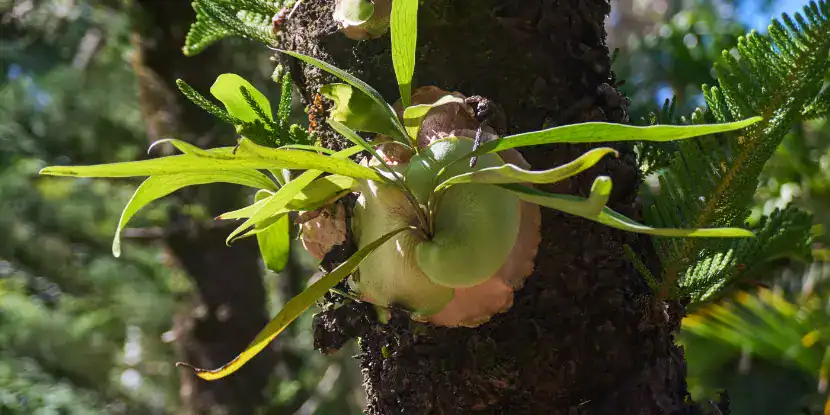
A staghorn fern in its native rainforest environment.
Q: Do staghorn ferns require soil?
No, they’re epiphytic and grow best when mounted or placed in baskets with minimal growing medium.
Q: How often should I fertilize my staghorn fern?
Fertilize monthly during spring and summer with a diluted, balanced liquid fertilizer. Avoid feeding in winter.
Q: Are staghorn ferns toxic to pets?
No, staghorn ferns are non-toxic to cats, dogs, and humans, making them a pet-friendly houseplant.
Q: Why are the edges of my fern fronds turning brown?
This usually indicates low humidity or underwatering. Increase moisture and ensure you’re watering correctly.
Q: How do I encourage pup formation for propagation?
Healthy plants in the right conditions will naturally develop pups. Providing ample light, regular feeding, and proper hydration encourages them to propagate.

